Saturday, 4 June 2011: Serious comics and serious silkweaving
Written 9 June 2011
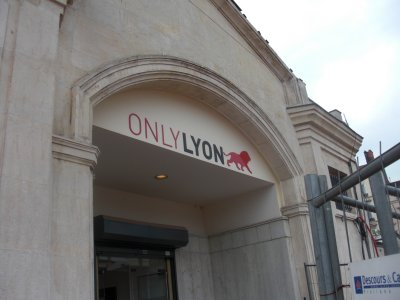
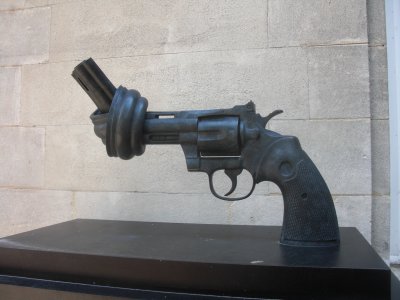 Saturday, we tried again for the resistance and deportation museum, because it was closed Sunday, and we were leaving Lyon on Monday morning. On the way to the metro, I got this photo of the "Only Lyon" logo, over the door of the Office de Tourisme. This time we found the museum open. Photography was forbidden inside, but this striking four-foot bronze sculpture was just outside its door; I couldn't find any title or attribution on it.
Saturday, we tried again for the resistance and deportation museum, because it was closed Sunday, and we were leaving Lyon on Monday morning. On the way to the metro, I got this photo of the "Only Lyon" logo, over the door of the Office de Tourisme. This time we found the museum open. Photography was forbidden inside, but this striking four-foot bronze sculpture was just outside its door; I couldn't find any title or attribution on it.
We started with the temporary exhibition, on protrayal of the resistance in comic strips and comic books (not necessarily "comic" ones). It started to show up early in the war, and even before France entered the war, but soon disappeared for the duration because of paper shortages. Entertainment uses were low on the priority list for the allocation of such resources. The bulk of the material covered was therefore produced after the war, and the theme persisted for decades, into the 1970s and 1980s.
The permanent collection was divided (although not very strictly) between the French resistance and the whole phenomenon of the deportation of Jews, gypsies, the handicapped, and others to the German and Polish concentration camps. Different sections covered prominent individuals in the resistance, the supporting roles played by others, the people in France (and in nearby countries) who hid potential deportees or helped them flee to safer territory. Particularly striking was a film of excerpts from the trial of Klaus Barbie, whose war crimes took place in Lyon. It featured testimony from many elderly survivors.
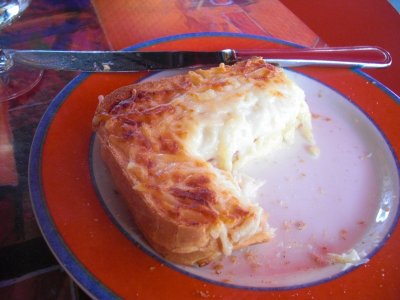
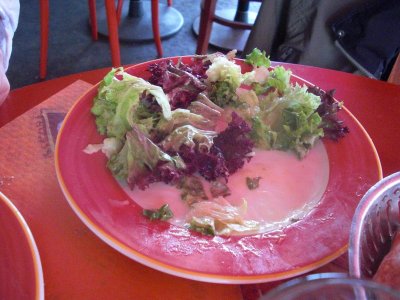 By the time we finished, it was 2 p.m., and most restaurants had stopped serving what they consider real lunch, so we took the tram and metro up to Croix Rousse for a croque monsieur (toasted cheese sandwich) with salad from the "snack" menu. Then we hiked a few blocks to the Maison des Canuts, museum and headquarters of the remaining artisanal silkweavers, who now number about 20, down from the 110,000 I mentioned somewhere above. Not only must they go through extensive apprenticeships in weaving, but they must now be able to maintain their own looms and Jacquard apparatuses, wind their own bobbins, string their own warps, prepare their own jacquard patterns, etc., because those trades have also mostly disappeared. "Canut" was originally a pejorative term, probably formed from "cannette," the little bobbin of silk inserted into the weaver's shuttle, but is today embraced with pride.
By the time we finished, it was 2 p.m., and most restaurants had stopped serving what they consider real lunch, so we took the tram and metro up to Croix Rousse for a croque monsieur (toasted cheese sandwich) with salad from the "snack" menu. Then we hiked a few blocks to the Maison des Canuts, museum and headquarters of the remaining artisanal silkweavers, who now number about 20, down from the 110,000 I mentioned somewhere above. Not only must they go through extensive apprenticeships in weaving, but they must now be able to maintain their own looms and Jacquard apparatuses, wind their own bobbins, string their own warps, prepare their own jacquard patterns, etc., because those trades have also mostly disappeared. "Canut" was originally a pejorative term, probably formed from "cannette," the little bobbin of silk inserted into the weaver's shuttle, but is today embraced with pride.
Waiting for the tour to begin, we spent a few minutes in the small museum of antique weaving implements. One of the displays was of a large swatch of solid burgundy-colored fabric featuring a complex floral pattern of raised velvet on a flat background. It was described as having been woven there at the Maison des Canuts between 1970 and 1998, and I'm almost certain it's the fabric the demonstration weaver was working on when we visited in 1991.
The tour started with an excellent lecture, spirited enough to hold the attention of the little kids in the crowd, about the history of silkweaving in Lyon, from the time of François I (who, in the early 16th century, gave the city the French monopoly on silkweaving so as not to have to send to Italy all the time for silk fabrics), through the time of Henri IV (when culture of the silkworms themselves was introduced, and mulberries were planted all over France, making production of raw silk a profitable seasonal sideline for many farmers and cutting further into the Italian hold on the market—silkworms were never actually cultivated in the Lyon area, though), through the time of Louis XIV (when miles of silk fabric were in constant demand by the aristocracy), through the revolution (when the silk market seriously crashed when all those silk-buying aristos were guillotined), through the time of Napoleon I (who, just as Jacquard was revolutionizing hand weaving, revived the silk trade by decreeing that all French officials must wear French silk uniforms and must buy new ones annually), through the 1830s (when the canuts struck for minimum prices and living wages), through the final decline in the handweaving trade with the introduction of industrial mechanized weaving in 1870. Still, the guide pointed out, industrial silkweaving is, to this day, limited to fabrics of 16 colors or less—some commissioned by Marie Antoinette used more than 100 colors. Anyone who wants silk with more than 16 colors woven in must still go to a handweaver with a good old Jacquard-assisted loom. Lyon is still the world center for that, as well as for a great deal of mechanized industrial weaving, particularly of upholstery and curtain fabrics. The lecture, with slides, also covered the whole process of producing raw silk from the cocoons.
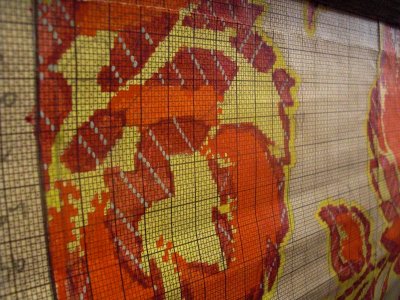
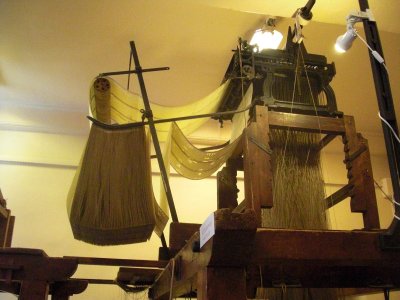 After the lecture, we were led across the street to the actual studio where weavers work. At the right is a small section of a pattern being prepared for punching on Jacquard cards. Each vertical column represents a warp thread and each row a woof thread. The pattern is then coded in the form of cardboard patterns, the "cartons" (cognate withboth English "carton," meaning cardboard, and "cartoon," in its original meaning of a sketch serving as a pattern), in which each woof thread is repesented by a row of punched holes in the cardboard. At the right is the jacquard apparatus mounted on top of the demonstration weaver's loom. You can see the long, fanfolded "carton" pattern, which is threaded through the metal apparatus at the top. There, each of an array of little metal pins, one for each warp thread, encounters either cardboard (in which case, it remains in place and its warp thread is not lifted) or a hole, in which case, it drops through, pulling a little metal hook (corresponding to its individual warp thread) forward to be engaged by the lifter).
After the lecture, we were led across the street to the actual studio where weavers work. At the right is a small section of a pattern being prepared for punching on Jacquard cards. Each vertical column represents a warp thread and each row a woof thread. The pattern is then coded in the form of cardboard patterns, the "cartons" (cognate withboth English "carton," meaning cardboard, and "cartoon," in its original meaning of a sketch serving as a pattern), in which each woof thread is repesented by a row of punched holes in the cardboard. At the right is the jacquard apparatus mounted on top of the demonstration weaver's loom. You can see the long, fanfolded "carton" pattern, which is threaded through the metal apparatus at the top. There, each of an array of little metal pins, one for each warp thread, encounters either cardboard (in which case, it remains in place and its warp thread is not lifted) or a hole, in which case, it drops through, pulling a little metal hook (corresponding to its individual warp thread) forward to be engaged by the lifter).
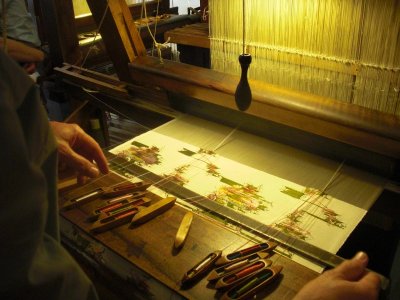
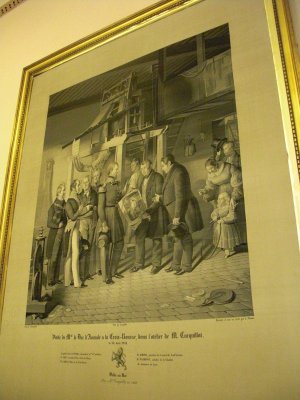 So the weaver stands in front of the loom, viewing his work from the wrong side—here, he's weaving fabric with a plain, pale background studded with sprigs and nosegays of amazingly colorful and detailed leaves and flowers. (How detailed? This fabric, about a yard wide, is being woven on 7000 warp threads.) Each time he stomps on a large wooden lever, the carton advances one row, and certain warp threads are lifted. If that row calls for the background color, a large number of threads (ca. half of them) will be lifted. He yanks the wooden handle dangling in front of him, and the background-color shuttle shoots across. He tamps that row, then stomps on the lever again. If, as is the case in the photo, the row calls for colored threads to be woven in, only a few warp threads will be lifted. The weaver then slides one or more of the small, hand shuttles under them, tamps them, and stomps on the pedal again. He has to know, for each pattern of threads lifted, which colors should be woven through. Sometimes just one color is used; other times, two or three are woven through together, for a blending effect. Of course, every few rows, at least one row of background color has to be used. The cartons have special punches (presumably along one edge) that cause a little bell to ding once or twice on certain rows. I'm not sure what one ding means, but two mean that a new color is introduced on this row. Again the weaver has to know which one. The pattern looks pretty blurry from the side that shows in the photo, but the sample he showed us of the other side was exquisite!
So the weaver stands in front of the loom, viewing his work from the wrong side—here, he's weaving fabric with a plain, pale background studded with sprigs and nosegays of amazingly colorful and detailed leaves and flowers. (How detailed? This fabric, about a yard wide, is being woven on 7000 warp threads.) Each time he stomps on a large wooden lever, the carton advances one row, and certain warp threads are lifted. If that row calls for the background color, a large number of threads (ca. half of them) will be lifted. He yanks the wooden handle dangling in front of him, and the background-color shuttle shoots across. He tamps that row, then stomps on the lever again. If, as is the case in the photo, the row calls for colored threads to be woven in, only a few warp threads will be lifted. The weaver then slides one or more of the small, hand shuttles under them, tamps them, and stomps on the pedal again. He has to know, for each pattern of threads lifted, which colors should be woven through. Sometimes just one color is used; other times, two or three are woven through together, for a blending effect. Of course, every few rows, at least one row of background color has to be used. The cartons have special punches (presumably along one edge) that cause a little bell to ding once or twice on certain rows. I'm not sure what one ding means, but two mean that a new color is introduced on this row. Again the weaver has to know which one. The pattern looks pretty blurry from the side that shows in the photo, but the sample he showed us of the other side was exquisite!
The framed "engraving" at the right is not in fact an engraving at all. It's a scarf jacquard-woven from black and white silk threads (no gray threads!). The last time we were here, the gift-shop was pushing a wide variety of such scenes, usually smaller and less detailed (and therefore less expensive) than this one. This year, they featured mostly clothing items—colorful or textured scarves, ties, etc.—but my favorite was the series of postcards purporting to show early 20th-century, hand-tinted photos, but slightly altered and hilariously captioned: Stiff and formal portrait of a large extended family, grouped in front of their house, but all—men, women, and children—sporting large, matching black mustaches (caption, "The terrible mustache epidemic of 1848"). A group of farmworkers sitting in front of a barn with funnels and large worm-like objects (caption, "Lyon, gavage des vers à soie," i.e., force feeding of the silkworms, as geese were force fed for foie gras). Room in a museum with glass acquaria filled with water but otherwise empty (caption, "municipal Museum, Hall of the Great Rhône Floods of 1884 and 1912"). The tall, brown "crayon" building, whose official name is "Le Tour Part-Dieu" for the nearby Part-Dieu train station, being pulled to its upright position by a huge chain disappearing into the clouds (caption, "Elevation of the crayon by God"; "by God," "par Dieu" in French, is a homonym of "Part-Dieu"). Half a dozen more; all very funny.
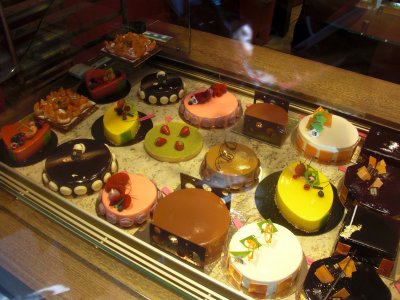 When I asked the weaver whether he would have been the one we saw weaving the burgundy velvet in 1991, he said no. That would have been the velvet specialist, who was not on duty that day, though his loom was set up, and we could view a partically finished piece of cobalt blue patterned velvet in progress.
When I asked the weaver whether he would have been the one we saw weaving the burgundy velvet in 1991, he said no. That would have been the velvet specialist, who was not on duty that day, though his loom was set up, and we could view a partically finished piece of cobalt blue patterned velvet in progress.
On the way back to the metro from the Maison des Canuts, we passed this amazing bakery window.
We got back to the our metro stop about 6:00 p.m. and crossed the open, gravel-paved Place Bellecour under a blazing hot sun to the Résideal, though the sky to the south looked a little dark. At 6:15 p.m., safely back in our room, David said, "Is that thunder?" I said, "Couldn't be; it's too long and continuous." But it was, and at 6:20 p.m., the skies opened. Good timing. By 7:30 p.m., when we walked back across the place to our restaurant, the rain had ended, the skies had cleared, and the air was fresh and cool.
Our dinner reservations were supposedly at Restaurant Nicolas Le Bec. Le Bec is the current darling of the Lyon restaurant scene; his much touted "La Rue Le Bec" will open soon in the newly developed area south of Perrache Station. When I made the reservation, though, several months ago, the place billed itself as "Le Bec & Takao." When we showed up, the name "Le Bec" was nowhere in evidence; the sign said "Takao Takano." I think I saw something in this year's GM Guide about Le Bec's taking less and less of a direct hand in the place—maybe he's turned it over to a protégé.
Nothing to complain about in the food, though. We both had the menu of the week, so we ate all the same things.
Amuse-bouche: Tall (i.e. 1 inch wide, 2.5 inches high) glasses of herbed fromage blanc topped with sweet tomato gazpacho; tarama piped onto little disks of savory shortbread; something white in little tart shells topped with shredded romaine.
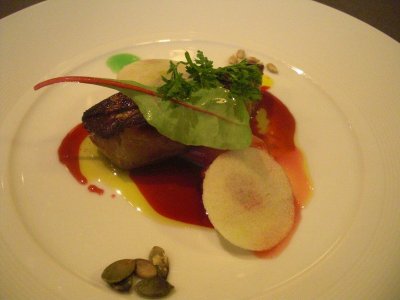
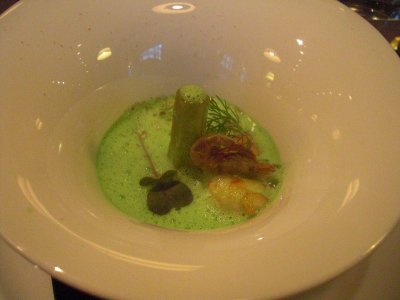 First course: Grilled duck foie gras balanced on a piece of with poached pink rhubarb, with raspberry and hibiscus juice. The white disks are fresh apple. Small pile of pumpkin seeds on one side of the plate, sunflower seeds on the other.
First course: Grilled duck foie gras balanced on a piece of with poached pink rhubarb, with raspberry and hibiscus juice. The white disks are fresh apple. Small pile of pumpkin seeds on one side of the plate, sunflower seeds on the other.
Second course: Roasted langoustine tails in a bouillon of fresh herbs. the tall green cylindrical object is the stem of a baby artichoke, cooked "poivrade" style, which is face down in the plate. The brownish object is a crispy roasted whole baby shrimp.
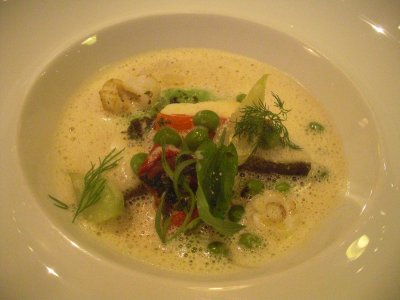
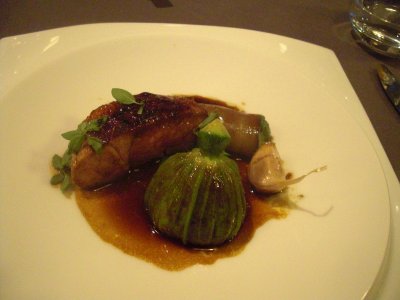 Third course: Steamed cod in a foamy broth with thin slices of cuttlefish, fresh peas, and little slivers of onion and fresh herbs.
Third course: Steamed cod in a foamy broth with thin slices of cuttlefish, fresh peas, and little slivers of onion and fresh herbs.
Fourth course: Milk-fed lamb roasted over a wood fire. Zucchini flowers stuffed "à vert," that is, with green stuff (chopped zuchini, herbs, and cheese?). A roasted garlic clove. A thin slice of eggplant wrapped into a cylinder around more of the green stuff. Juice of "sweet spices." The lamb was accompanied by a bowl of wonderful creamy mashed potatoes, just like those at Les Loges, but this time made with butter rather than olive oil. Delish.
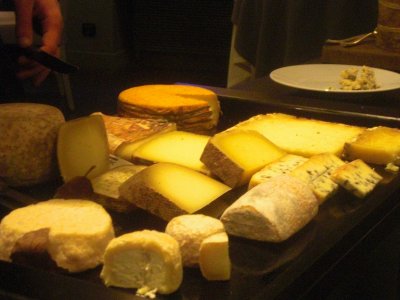
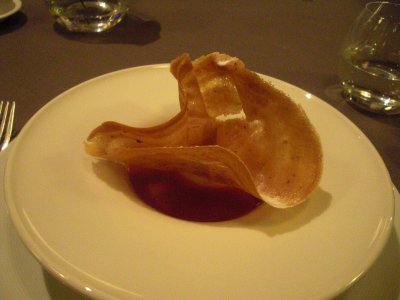 Cheese: From this assortment, I chose some Salers (one of the yellow slabs), some Saint Marcellin, and a dry chevre. David had some Sain Marcellin, too, but he was mostly interested in a magnificent Stilton that arrived on its own separate cart. Rather than the foil-wrapped cylinders we usually see, it was coated with a brown rind, bound with five or six horizontal bands of some sort of dried stalk (rushes?). It stood about 18 inches high, and the waitress scooped David's serving out of the top with a big spoon, as is traditional. David said it was great!
Cheese: From this assortment, I chose some Salers (one of the yellow slabs), some Saint Marcellin, and a dry chevre. David had some Sain Marcellin, too, but he was mostly interested in a magnificent Stilton that arrived on its own separate cart. Rather than the foil-wrapped cylinders we usually see, it was coated with a brown rind, bound with five or six horizontal bands of some sort of dried stalk (rushes?). It stood about 18 inches high, and the waitress scooped David's serving out of the top with a big spoon, as is traditional. David said it was great!
The predessert was an outstanding cold strawberry soup topped with an impossibly thin, tender, and crispy cookie bent into this floral shape.
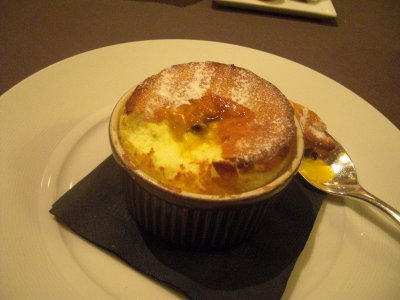
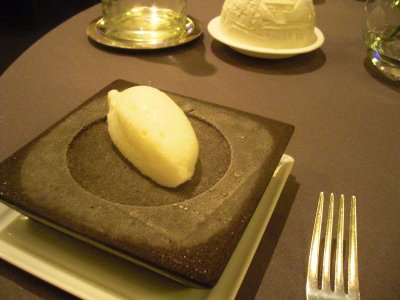 I'm afraid the lime souffle with ginger-passionfruit sauce was too much for me. It was very hot and very tangy, even before the waiter poured equally hot and even tangier passion-fruit sauce into it. My poor salivary glands went into spasms! As it cooled, and as I got to the less-fluffy and less-tangy bottom layer, it got better. The vanilla sorbet on the side was very good, though, and it was served on this four-inch square, two-inch high, frozen rock, which kept it frozen to the last bite.
I'm afraid the lime souffle with ginger-passionfruit sauce was too much for me. It was very hot and very tangy, even before the waiter poured equally hot and even tangier passion-fruit sauce into it. My poor salivary glands went into spasms! As it cooled, and as I got to the less-fluffy and less-tangy bottom layer, it got better. The vanilla sorbet on the side was very good, though, and it was served on this four-inch square, two-inch high, frozen rock, which kept it frozen to the last bite.
The mignardises were two tonka-bean flavored chocolates (could have been coffee-flavored), two tiny financière cakes, and two soft caramels.
previous entry
List of Entries
next entry

 Saturday, we tried again for the resistance and deportation museum, because it was closed Sunday, and we were leaving Lyon on Monday morning. On the way to the metro, I got this photo of the "Only Lyon" logo, over the door of the Office de Tourisme. This time we found the museum open. Photography was forbidden inside, but this striking four-foot bronze sculpture was just outside its door; I couldn't find any title or attribution on it.
Saturday, we tried again for the resistance and deportation museum, because it was closed Sunday, and we were leaving Lyon on Monday morning. On the way to the metro, I got this photo of the "Only Lyon" logo, over the door of the Office de Tourisme. This time we found the museum open. Photography was forbidden inside, but this striking four-foot bronze sculpture was just outside its door; I couldn't find any title or attribution on it.
 By the time we finished, it was 2 p.m., and most restaurants had stopped serving what they consider real lunch, so we took the tram and metro up to Croix Rousse for a croque monsieur (toasted cheese sandwich) with salad from the "snack" menu. Then we hiked a few blocks to the Maison des Canuts, museum and headquarters of the remaining artisanal silkweavers, who now number about 20, down from the 110,000 I mentioned somewhere above. Not only must they go through extensive apprenticeships in weaving, but they must now be able to maintain their own looms and Jacquard apparatuses, wind their own bobbins, string their own warps, prepare their own jacquard patterns, etc., because those trades have also mostly disappeared. "Canut" was originally a pejorative term, probably formed from "cannette," the little bobbin of silk inserted into the weaver's shuttle, but is today embraced with pride.
By the time we finished, it was 2 p.m., and most restaurants had stopped serving what they consider real lunch, so we took the tram and metro up to Croix Rousse for a croque monsieur (toasted cheese sandwich) with salad from the "snack" menu. Then we hiked a few blocks to the Maison des Canuts, museum and headquarters of the remaining artisanal silkweavers, who now number about 20, down from the 110,000 I mentioned somewhere above. Not only must they go through extensive apprenticeships in weaving, but they must now be able to maintain their own looms and Jacquard apparatuses, wind their own bobbins, string their own warps, prepare their own jacquard patterns, etc., because those trades have also mostly disappeared. "Canut" was originally a pejorative term, probably formed from "cannette," the little bobbin of silk inserted into the weaver's shuttle, but is today embraced with pride.
 After the lecture, we were led across the street to the actual studio where weavers work. At the right is a small section of a pattern being prepared for punching on Jacquard cards. Each vertical column represents a warp thread and each row a woof thread. The pattern is then coded in the form of cardboard patterns, the "cartons" (cognate withboth English "carton," meaning cardboard, and "cartoon," in its original meaning of a sketch serving as a pattern), in which each woof thread is repesented by a row of punched holes in the cardboard. At the right is the jacquard apparatus mounted on top of the demonstration weaver's loom. You can see the long, fanfolded "carton" pattern, which is threaded through the metal apparatus at the top. There, each of an array of little metal pins, one for each warp thread, encounters either cardboard (in which case, it remains in place and its warp thread is not lifted) or a hole, in which case, it drops through, pulling a little metal hook (corresponding to its individual warp thread) forward to be engaged by the lifter).
After the lecture, we were led across the street to the actual studio where weavers work. At the right is a small section of a pattern being prepared for punching on Jacquard cards. Each vertical column represents a warp thread and each row a woof thread. The pattern is then coded in the form of cardboard patterns, the "cartons" (cognate withboth English "carton," meaning cardboard, and "cartoon," in its original meaning of a sketch serving as a pattern), in which each woof thread is repesented by a row of punched holes in the cardboard. At the right is the jacquard apparatus mounted on top of the demonstration weaver's loom. You can see the long, fanfolded "carton" pattern, which is threaded through the metal apparatus at the top. There, each of an array of little metal pins, one for each warp thread, encounters either cardboard (in which case, it remains in place and its warp thread is not lifted) or a hole, in which case, it drops through, pulling a little metal hook (corresponding to its individual warp thread) forward to be engaged by the lifter).
 So the weaver stands in front of the loom, viewing his work from the wrong side—here, he's weaving fabric with a plain, pale background studded with sprigs and nosegays of amazingly colorful and detailed leaves and flowers. (How detailed? This fabric, about a yard wide, is being woven on 7000 warp threads.) Each time he stomps on a large wooden lever, the carton advances one row, and certain warp threads are lifted. If that row calls for the background color, a large number of threads (ca. half of them) will be lifted. He yanks the wooden handle dangling in front of him, and the background-color shuttle shoots across. He tamps that row, then stomps on the lever again. If, as is the case in the photo, the row calls for colored threads to be woven in, only a few warp threads will be lifted. The weaver then slides one or more of the small, hand shuttles under them, tamps them, and stomps on the pedal again. He has to know, for each pattern of threads lifted, which colors should be woven through. Sometimes just one color is used; other times, two or three are woven through together, for a blending effect. Of course, every few rows, at least one row of background color has to be used. The cartons have special punches (presumably along one edge) that cause a little bell to ding once or twice on certain rows. I'm not sure what one ding means, but two mean that a new color is introduced on this row. Again the weaver has to know which one. The pattern looks pretty blurry from the side that shows in the photo, but the sample he showed us of the other side was exquisite!
So the weaver stands in front of the loom, viewing his work from the wrong side—here, he's weaving fabric with a plain, pale background studded with sprigs and nosegays of amazingly colorful and detailed leaves and flowers. (How detailed? This fabric, about a yard wide, is being woven on 7000 warp threads.) Each time he stomps on a large wooden lever, the carton advances one row, and certain warp threads are lifted. If that row calls for the background color, a large number of threads (ca. half of them) will be lifted. He yanks the wooden handle dangling in front of him, and the background-color shuttle shoots across. He tamps that row, then stomps on the lever again. If, as is the case in the photo, the row calls for colored threads to be woven in, only a few warp threads will be lifted. The weaver then slides one or more of the small, hand shuttles under them, tamps them, and stomps on the pedal again. He has to know, for each pattern of threads lifted, which colors should be woven through. Sometimes just one color is used; other times, two or three are woven through together, for a blending effect. Of course, every few rows, at least one row of background color has to be used. The cartons have special punches (presumably along one edge) that cause a little bell to ding once or twice on certain rows. I'm not sure what one ding means, but two mean that a new color is introduced on this row. Again the weaver has to know which one. The pattern looks pretty blurry from the side that shows in the photo, but the sample he showed us of the other side was exquisite! When I asked the weaver whether he would have been the one we saw weaving the burgundy velvet in 1991, he said no. That would have been the velvet specialist, who was not on duty that day, though his loom was set up, and we could view a partically finished piece of cobalt blue patterned velvet in progress.
When I asked the weaver whether he would have been the one we saw weaving the burgundy velvet in 1991, he said no. That would have been the velvet specialist, who was not on duty that day, though his loom was set up, and we could view a partically finished piece of cobalt blue patterned velvet in progress.
 First course: Grilled duck foie gras balanced on a piece of with poached pink rhubarb, with raspberry and hibiscus juice. The white disks are fresh apple. Small pile of pumpkin seeds on one side of the plate, sunflower seeds on the other.
First course: Grilled duck foie gras balanced on a piece of with poached pink rhubarb, with raspberry and hibiscus juice. The white disks are fresh apple. Small pile of pumpkin seeds on one side of the plate, sunflower seeds on the other.
 Third course: Steamed cod in a foamy broth with thin slices of cuttlefish, fresh peas, and little slivers of onion and fresh herbs.
Third course: Steamed cod in a foamy broth with thin slices of cuttlefish, fresh peas, and little slivers of onion and fresh herbs.
 Cheese: From this assortment, I chose some Salers (one of the yellow slabs), some Saint Marcellin, and a dry chevre. David had some Sain Marcellin, too, but he was mostly interested in a magnificent Stilton that arrived on its own separate cart. Rather than the foil-wrapped cylinders we usually see, it was coated with a brown rind, bound with five or six horizontal bands of some sort of dried stalk (rushes?). It stood about 18 inches high, and the waitress scooped David's serving out of the top with a big spoon, as is traditional. David said it was great!
Cheese: From this assortment, I chose some Salers (one of the yellow slabs), some Saint Marcellin, and a dry chevre. David had some Sain Marcellin, too, but he was mostly interested in a magnificent Stilton that arrived on its own separate cart. Rather than the foil-wrapped cylinders we usually see, it was coated with a brown rind, bound with five or six horizontal bands of some sort of dried stalk (rushes?). It stood about 18 inches high, and the waitress scooped David's serving out of the top with a big spoon, as is traditional. David said it was great!
 I'm afraid the lime souffle with ginger-passionfruit sauce was too much for me. It was very hot and very tangy, even before the waiter poured equally hot and even tangier passion-fruit sauce into it. My poor salivary glands went into spasms! As it cooled, and as I got to the less-fluffy and less-tangy bottom layer, it got better. The vanilla sorbet on the side was very good, though, and it was served on this four-inch square, two-inch high, frozen rock, which kept it frozen to the last bite.
I'm afraid the lime souffle with ginger-passionfruit sauce was too much for me. It was very hot and very tangy, even before the waiter poured equally hot and even tangier passion-fruit sauce into it. My poor salivary glands went into spasms! As it cooled, and as I got to the less-fluffy and less-tangy bottom layer, it got better. The vanilla sorbet on the side was very good, though, and it was served on this four-inch square, two-inch high, frozen rock, which kept it frozen to the last bite.